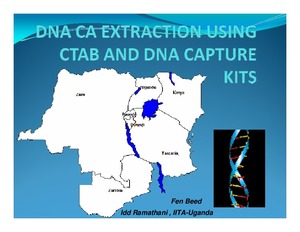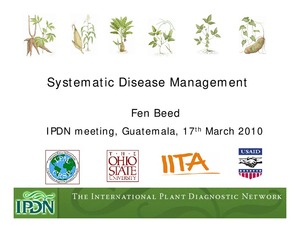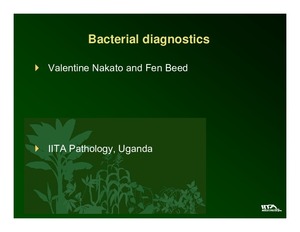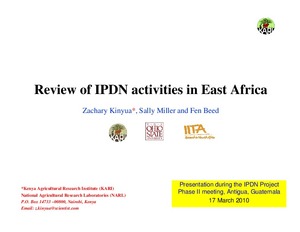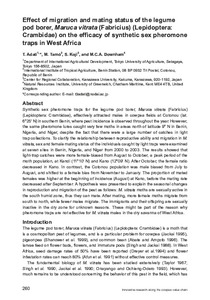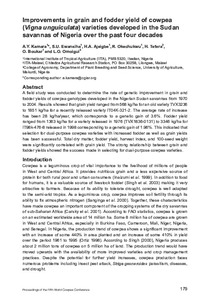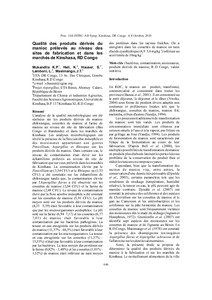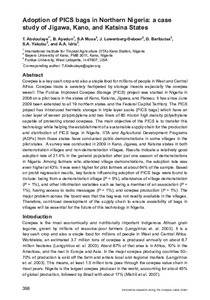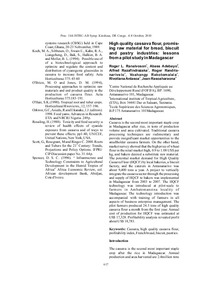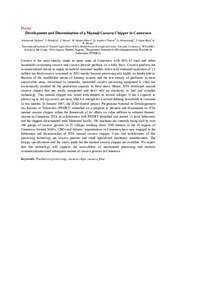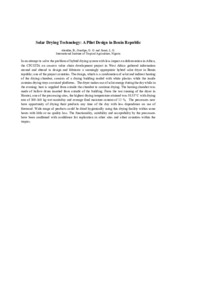Welcome to the International Institute of Tropical Agriculture Research Repository
Conference Documents: Recent submissions
Now showing items 681-700 of 726
-
DNA CA extraction using CTAB and DNA capture kits
(International Institute of Tropical Agriculture, 2010-01) -
Systematic disease management
(International Plant Diagnostic Network, 2010) -
Bacterial diagnostics
(International Institute of Tropical Agriculture, 2010) -
Review of IPDN activities in East Africa
(International Plant Diagnostic Network, 2010) -
Analyses of different processes governing soil erosion by water in the tropics
(International Association of Hydrological Sciences, 1981-06)Soil erosion hazard in tropical Africa is a serious threat towards sustained productivity. The available basic research information on soil, climate, and land use is rather sketchy and indicates that the severity of the erosion hazard may be attributed to soil characteristics, low soil loss tolerance, and climatic factors that lead to accelerated soil erosion following a change in land use. Researchers in the tropics have yet to establish appropriate methods for monitoring and estimating, precisely ... -
The impact of the emergency response to the outbreak of the cassava mosaic disease in the Democratic Republic of Congo
(International Society For Tropical Root Crops-Africa Branch, 2012-02)This paper evaluates the impact of an emergency research for development project implemented in the Democratic Republic of Congo from 2000 to 2009 by a various actors including the International Institute of Tropical Agriculture in response to the outbreak of the Cassava Mosaic Disease that threatened the national food security. It applies methods developed in the econometric and statistical treatment effects literature on evaluation of social programs. The study evaluates impact by analyzing ... -
An historical review of progress to control key cowpea biotic constraints in Burkina Faso
(International Institute of Tropical Agriculture, 2012)Cowpea farming practices have been ongoing for millennia and have always faced various challenges including diseases, insects, and weeds, that lower its yield to no more than 200 kg/ha. This economically and nutritionally important crop has been a major research focus of the International Institute of Tropical Agriculture (IITA) and of several national agricultural research systems (NARS) in sub-Saharan Africa (SSA) and partner universities. Researchers have begun to develop sustainable solutions ... -
Effect of migration and mating status of the legume pod borer, Maruca vitrata (Fabricius) (Lepidoptera: Crambidae) on the efficacy of synthetic sex pheromone traps in West Africa
(International Institute of Tropical Agriculture, 2012)Synthetic sex pheromone traps for the legume pod borer, Maruca vitrata (Fabricius) (Lepidoptera: Crambidae), effectively attracted males in cowpea fields at Cotonou (lat. 6°25' N) in southern Benin, where pest incidence is observed throughout the year. However, the same pheromone lures caught very few moths in areas north of latitude 9° N in Benin, Nigeria, and Niger, despite the fact that there were a large number of catches in light trap collections. To clarify the relationship between reproductive ... -
Improvements in grain and fodder yield of cowpea (Vigna unguiculata) varieties developed in the Sudan savannas of Nigeria over the past four decades
(International Institute of Tropical Agriculture, 2012)A field study was conducted to determine the rate of genetic improvement in grain and fodder yields of cowpea genotypes developed in the Nigerian Sudan savannas from 1970 to 2004. Results showed that grain yield ranged from 568 kg/ha for an old variety TVX3236 to 1851 kg/ha for a recently released variety IT04K-321-2. The average rate of increase has been 28 kg/ha/year, which corresponds to a genetic gain of 3.6%. Fodder yield ranged from 1363 kg/ha for a variety released in 1976 (TVX1836-0131) ... -
Improving the productivity of cowpea in the savannas of northeast Nigeria through participatory evaluation and dissemination of improved varieties
(International Institute of Tropical Agriculture, 2012)Cowpea is a major food and cash crop in northern Nigeria, providing nutritious grain and a less expensive source of protein for both the rural poor and urban consumers. A number of improved varieties have been developed combining diverse plant type, and different maturity periods, with resistance or tolerance to several diseases, insect pests, and parasitic weeds and possessing other good agronomic traits. Despite this, farmers in northeast Nigeria have continued to grow predominantly local ... -
The influence and implications of climate change and variability on Coffea arabica in the East African highlands: Mt. Kilimanjaro case study
(Association for Science and Information on Coffee, 2012)The coffee growing regions on the slopes of Mt. Kilimanjaro have become progressively warmer and drier over the past 48 years. The minimum temperature is the predominant climatic variable which influences coffee yields over longer-term climatic change. In contrast, the amounts of rainfall and in particular the timing of rainfall at specific growth periods are the most important climatic variables governing coffee yields on the micro-climatic scale. The predicted increase in climate change (temperature) ... -
Qualité des produits dérivés du manioc prélevés au niveau des sites de fabrication et dans les marchés de Kinshasa, RD Congo
(International Association of Hydrological Sciences, 2012-02)L'analyse de la qualité microbiologique ont été réalisées sur les produits dérivés du manioc chikwangue, cossettes de manioc et farine de manioc au niveau du site de fabrication (Bas Congo et Bandundu) et dans les marchés de Kinshasa. Les analyses microbiologiques ont révélé la présence de la flore aérobie mésophile et des moisissures appartenant aux genres Penicillium, Aspergillus et Rhizopus sur les produits dérivés du manioc. Dans certains cas, le niveau de contamination était élevé sur ... -
Adoption of PICS bags in Northern Nigeria: a case study of Jigawa, Kano, and Katsina States
(International Institute of Tropical Agriculture, 2012)Cowpea is a key cash crop and also a staple food for millions of people in West and Central Africa. Cowpea trade is severely hampered by storage insects especially the cowpea weevil. The Purdue Improved Cowpea Storage (PICS) project was started in Nigeria in 2008 on a pilot basis in the states of Kano, Katsina, Jigawa, and Plateau. It has since June 2009 been extended to all 19 northern states and the Federal Capital Territory. The PICS project has introduced hermetic storage in triple layer sacks ... -
High quality cassava flour, promising raw material for bread, biscuit and pastry industries: lessons from a pilot study in Madagascar
(International Society For Tropical Root Crops-Africa Branch, 2012-02)Cassava is the second most important staple crop in Madagascar after rice, in term of production volume and area cultivated. Traditional cassava processing techniques are rudimentary and provide insignificant market opportunities to the smallholder cassava farmers. On the other hand, market survey showed that the high price of wheat flour in the retail market high, 0.9 to 1.08 US$ per kg, and bakers desired a substitute raw material. The potential market demand for High Quality Cassava Flour (HQCF) ... -
Adding value to Africa's cassava in a global environment
(International Association of Hydrological Sciences, 2012-02)Based on experiences in the Cassava: Adding Value for Africa (C:AVA) project, this paper examines emerging issues and lessons for adding value to cassava, one of Africa's widely cultivated staples in ways that contribute to the global market environment as well as bring benefits to small holders on the continent. The main issues discussed include: competiveness in the supply of raw material, assisting smallholders to produce value-added products sustainably and competitively, ensuring and maintaining ... -
Effects of fermentation length and varieties on the pasting properties of sour cassava starch
(International Society For Tropical Root Crops-Africa Branch, 2012-02)The effects of length of fermentation (5, 10, 15, 20 and 25 days) on pasting properties of sour starches produced from six cassava varieties were investigated. There were significant differences (p< 0.05) in pasting properties except pasting temperature and breakdown irrespective of the days of fermentation. Peak viscosity ranged from 308.50 to 466.63 RVA, trough ranged from 67.25 to 198.75 RVA, break down ranged from 147.71 to 320.25 RVA, final viscosity ranged from 100.29 to 233.00 RVA, set back ... -
New approaches for quantifying carotenoids content in cassava roots
(International Society For Tropical Root Crops-Africa Branch, 2012-02)Cassava is an ideal vehicle for delivering provitamin A carotenoids to human populations affected by deficiency of this important micronutrient. Rapid cycling recurrent selection has proven to be very effective increasing carotenoids levels in cassava. The maximum level of total carotenoids increased by about 3 μg / g of fresh root each year. As breeding populations evolve large populations are developed and the selection among them becomes increasingly difficult because most genotypes show intense ... -
Proximate composition and physical properties of steamed sour cassava starch bread
(International Association of Hydrological Sciences, 2012-02)The effects of steaming (10min, 20min and 30min) on the properties of sour cassava starch bread were evaluated. Properties examined include pH, moisture content, protein, ash, starch, sugar, amylose content and sensory analysis. Amylose content ranged between (14.04-15.73%), Amylopectin ranged between (84.27-85.96 %), protein content ranged between (3.85-4.18%), Starch and Sugar content ranged between (68.07- 69.01%) and (10.12-10.34%) respectively. As the level of steaming increases the fat ... -
Development and dissemination of a manual cassava chipper in Cameroon
(International Association of Hydrological Sciences, 2012-02)Cassava (Manihot esculenta Crantz) is the main starchy staple in many parts of Cameroon, with 80% of rural and urban households consuming cassava and cassava derived products on a daily basis. Cassava products are commercialized mostly to supply household consumer markets with a total estimated equivalent of 1.1 million ton fresh cassava consumed in 2002 mainly because processing rely highly on family labour. Because of the smallholder nature of farming systems and the low density of producers in ... -
Solar drying technology: a pilot design in Benin Republic
(International Association of Hydrological Sciences, 2012-02)An appropriate drying system remains a critical factor for the development of cassava enterprises in Africa, most especially at the rural sector. As part of solving this problem, the Cassava value chain development in West Africa - a project sponsored by the Common Fund for Commodities source information on existing solar drying systems in Nigeria, Ghana, Uganda, Cameroon, and Sierra Leone. Findings from the survey assisted in the design and fabrication of an hybrid solar drying system with less ...

